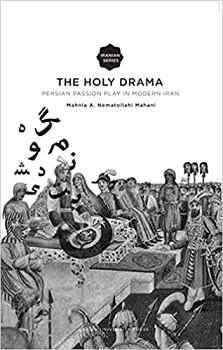The Holy Drama: Persian Passion Play in Modern Iran
The book The Holy Drama: Persian Passion Play in Modern Iran analyses the role of the Prophet’s granddaughter in modern twentieth-century Iran and, more specifically, how Iranian women perceived her as the archetype of resistance and protest against the tyrannical Pahlavi monarch during the Islamic Revolution of 1979.
 | |
| Author | Mahina A. Nematollahi |
|---|---|
| Language | English |
| Published | 2014 |
| Publisher | Leiden University Press |
| Pages | 220 |
About the authorEdit
Mahnia A. Nematollahi Mahani worked as an editor at the Center for International Cultural Studies in Tehran, before she started her academic career in Persian Studies at Leiden University.
About the bookEdit
This book published in Leiden University Press (December 15, 2014), has 220 pages and best sellers rank of 7,660,520 in Books.
In this book, the author examines the major role of ta‘ziya and its religious prohibitions and restrictions, and shows how devotional themes such as predestination, salvation, intercession, free will and martyrdom are used in ta‘ziya texts.
About the bookEdit
IntroductionEdit
This study focuses on the character of Zeynab, Imam Ḥuseyn’s sister, the third Shiite Imam. The way she demonstrated exceptional behavior in standing up to the Umayyad caliph Yazid (d.63/683) 2 during and after the battle of Karbala is a crucial issue for Shiites. After analyzing Zeynab’s behavior, the author focuses on how modern Iranian women have received Zeynab, especially during the Iran-Iraq war in the 1980s.
Chapter 1: Ashura, the Martyrdom of Imam HuseynEdit
This chapter tells the story of the succession of the leadership of the Muslim community, which took place after Mu'awiyah's death. As the Shiites believed in the leadership of the Muslim community by the descendants of Imam Ali, after his death, his two sons, first Ḥasan and then Huseyn, were the Shiite Imams, and the Imamate was then handed down from father to son. The elder son Hasan was deprived of the caliphate by Mu‘awiya. It is the life and tragic death of the second son, and third Imam, Ḥuseyn, which is the subject of ta‘ziya. The author in this chapter examines the concept of Imama in Shiite tradition and martyrdom (Šahadat).
Chapter 2: EschatologyEdit
This chapter examines the Islamic eschatology. The events that precede the Last Day (yawm al-akher) are an important theme in the Qur’an. Several verses warn people of the day of resurrection: a day that is already specified but is not known to men, including the Prophet. The Qur’an refers to several natural apocalyptic signs as preludes of the Last Day. The author examines eschatology in the ta‘ziya texts. She discusses about important elements in the ta‘ziya texts like time and setting.
Chapter 3: Doctrines and Philosophy in Ta‘ziyaEdit
The author in this chapter examines two of the most recurring concepts in ta‘ziya, predestination (qadar) and free will (ekhtiyar), the Shiite concept of salvation.
Chapter 4: Zeynab in the Passion PlayEdit
This chapter discusses the role of Zeynab, Imam Ḥuseyn’s sister, the third Shiite Imam. The role of Zeynab as a leader is signified both in history and in the ta‘ziya texts. As a leader, she teaches her family and, indirectly, the audience that they have to sacrifice themselves for the sake of justice. She is a model for her fellow women and subsequent generations of Shiite women. She is an archetype of sacrificial behaviour. In the ta‘ziya texts, Zeynab has a symbolic role as the holder of the Shiite Trusts (amanat, the things entrusted for safekeeping). On the Day of Judgement, these Trusts will exempt Shiites from punishment. Zeynab is the preserver of the line of Shiite Imams in another way, because she prevented Imam Zeyn al- Abedin from being killed. After the battle of Karbala, the severed heads of the dead were taken to Yazid’s court, where Yazid desecrated them.
Chapter 5: The Transformation of HistoryEdit
In this chapter the author examines several examples of the transformation of historical facts into oral tradition. In Shiite tradition, the events of Karbala and the martyrdom of Imam Ḥuseyn and his companions were crucial, and their commemoration has become the most important devotional event in the Shiite calendar. The ta‘ziya composers have added details to what is known about the events of Karbala: details chosen to stimulate the audience’s empathy, like the murder of Imam Huseyn, Zeynab’s behavior in rescuing her nephew, Ali Ibn Ḥuseyn, from death, and the final example of the effect of the oral tradition is the person of Sakina, the four-year-old daughter of Imam Ḥuseyn who died during the imprisonment in Damascus.
Chapter 6: Pre-Islamic Iranian Elements in the Ta‘ziya TextsEdit
This chapter examines another important feature of the ta‘ziya texts that is the way Shiite Arab traditions are linked to Iran. The ta‘ziya composers give the events of Karbala an Iranian flavor by employing words and expressions that are integral to Iranian life today. They also make plot links to Iran, so that the events of Karbala seem more familiar to the audience. Another important feature that makes the ta‘ziya seem more familiar for Iranians is its suffusion with motifs drawn from the Persian ethic of kingship. Hereditary kingship has very ancient roots in Iran. Terms such as king (Shah), crown prince (vali‘ahd), and prince (Shahzada) are associated with social rank in Persian.
ConclusionEdit
The present study sheds light on several aspects of ta‘ziya in Iran. It appears to have some continuity with the pre-Islamic dramatic tragedies of Mitra (an Iranian god), of Zarir and of Siyavuš.